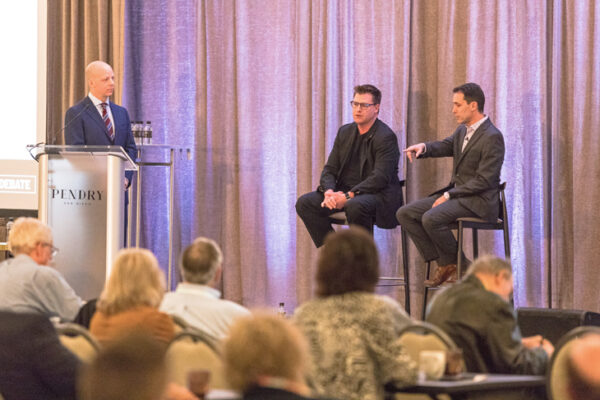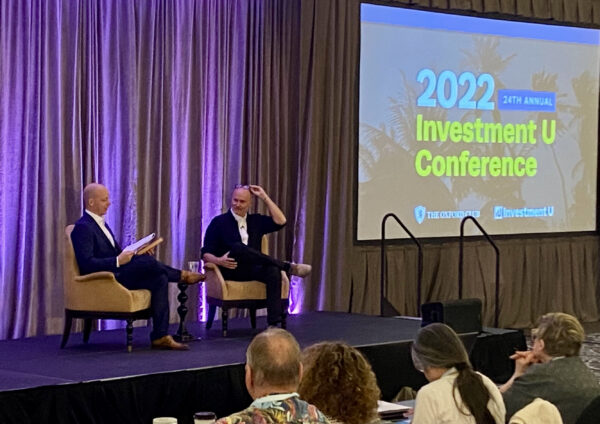The “Blue Zones” of Wealth and Happiness
- According to a world-renowned researcher and bestselling author, there are three things that lead to happiness.
- Today, Alexander Green shares them and adds a fourth item that can help us all achieve true wealth.
A few years ago, a friend invited me to a weekend social event at his ranch near Austin.
There I met a journalist who had spent years researching the health, diet and lifestyles of the world’s longest-lived people in places like Okinawa, Japan; Ikaria, Greece; and Loma Linda, California.
“Wait a minute,” I interjected. “Are you that Blue Zones guy?”
He was.
I was talking to Dan Buettner, the National Geographic fellow and bestselling author of several books on his “Blue Zones” research.
Our conversation later turned to the financial markets and the search for practical investment solutions.
After a few minutes, Dan said, “Hold on. Are you that Gone Fishin’ guy?”
Over the next couple days, we talked for hours, played a combative game of tennis and promised to stay in touch.
We’ve since become good buddies.
Last year we hiked a portion of the Pacific Crest Trail near Bend, Oregon. And just a few weeks ago, a group of 14 of us – plus two guides – explored the gorgeous Picos de Europa mountains along the northern coast of Spain.
I read one of Dan’s best books last year, The Blue Zones of Happiness: Lessons From the World’s Happiest People. I highly recommend it.
Yes, I know. Bookstores are swimming in titles about happiness and how to find it.
I plowed through dozens during the years I wrote my weekly Beyond Wealth column.
Let me save you a lot of time and trouble: If you’re interested in the subject, read Dan’s book first.
The Blue Zones of Happiness is a fascinating exploration of the world’s most satisfied people – and how you can tweak your own life to make it more fulfilling.
That begins, of course, with defining what happiness is.
In Dan’s view, it comes down to three P’s: pleasure, purpose and pride.
Pleasure includes the time we spend doing things we enjoy, especially with friends and family.
Purpose is the strand of happiness that results from living out your values.
And pride is feeling satisfied with your position in life, your accomplishments personal or professional.
The book kicks off with a Blue Zones Happiness Test that reveals your current state of happiness.
It also points out where you should concentrate your efforts to lead a more satisfying life.
For example, I scored fairly high on all three measures of happiness. But I learned that I could notch things up a bit if I spent more time socializing, volunteered more frequently and got back to a regular meditation schedule.
Dan’s research shows that most of us are happier if we live with a loving partner, have friends we can confide in, get at least 30 minutes of physical exercise daily, own a dog, have clearly defined goals, spend less than an hour a day on social media and can articulate our purpose in life.
We find it tougher to be truly happy if we are overworking, overspending or undersocializing.
(I love spending time with friends, for example. But I’m an undersocializer. Research and writing is a passion, but it’s a solitary business.)
Dan emphasizes several worthwhile steps, including getting outside more, pursuing a favorite hobby, getting a daily dose of humor and practicing generosity.
Better than simply delineating ideas and showing how they’ll boost your happiness, he offers dozens of straightforward, actionable ideas to nudge you in the right direction.
The book is well-researched, eminently practical and full of wisdom about how to live the kind of life where you feel like you are truly flourishing.
Of course, there is another thing that makes life happier for most of us: money.
The best things in life may be free, but there are generally strings attached.
It’s hard to imagine, for example, that anyone is truly happy if they are worried about retirement, living paycheck to paycheck or two steps ahead of the debt collector.
In my next column, I’ll cover Dan’s (and my) ideas about money and happiness.
[adzerk-get-ad zone="245143" size="4"]About Alexander Green
Alexander Green is the Chief Investment Strategist of The Oxford Club, the world’s largest financial fellowship. For 16 years, Alex worked as an investment advisor, research analyst and portfolio manager on Wall Street. After developing his extensive knowledge and achieving financial independence, he retired at the age of 43.
Since then, he has been living “the second half of his life.” He runs The Oxford Communiqué, one of the most highly regarded publications in the industry. He also operates three fast-paced trading services: The Momentum Alert, The Insider Alert and Oxford Microcap Trader. In addition, he writes for Liberty Through Wealth, a free daily e-letter focused on financial freedom.
Alex is also the author of four New York Times bestselling books: The Gone Fishin’ Portfolio: Get Wise, Get Wealthy… and Get On With Your Life; The Secret of Shelter Island: Money and What Matters; Beyond Wealth: The Road Map to a Rich Life; and An Embarrassment of Riches: Tapping Into the World’s Greatest Legacy of Wealth.






